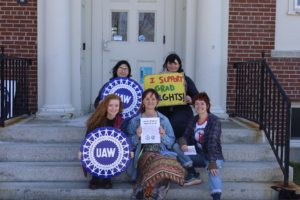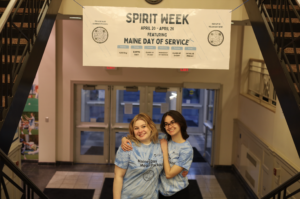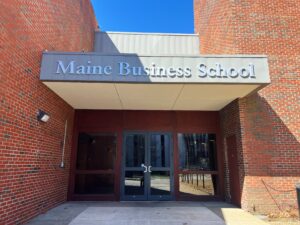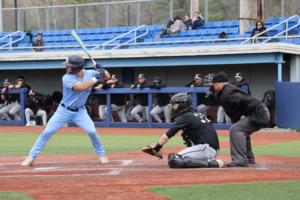University of Maine students participated in the research symposium at the Cross Insurance Center in Bangor on Tuesday, April 17. The event was sponsored by the Center for Undergraduate Research (CUGR) and the Graduate Student Government (GSG).
The sports arena was busy with morning and afternoon sessions of the student symposium, a yearly event held in April. It is only open to University of Maine and UMaine Machias students. CUGR allows undergraduate and graduate students from all disciplines to present research in their respective colleges, according to director Ali Abedi.
He mentioned that this year was the largest symposium, with over 2,000 attendees. Abedi said that the first symposium took place on campus, but in the last decade it has moved to larger venues to accommodate the growing number of participants.
“In the past…we only had engineering, and hard sciences and that was pretty much it, but in the past two three years, we started to get other people involved, and this year, we had every discipline involved,” Abedi said.
A total of 1,360 students participated in creating 377 projects for the symposium.
Although CUGR is commonly referred to as the “senior seminar,” Abedi wants future participants to know that the program is open to all students of any year or discipline. He mentioned that while the majority of students are of junior and senior standing, there are a few first and second year students who take part each year.
Along with the yearly symposium, CUGR also provides students with research-focused academic opportunities. Undergraduate and graduate students alike have the option of applying for internships, fellowships and travel grants to conduct research within their own interests.
CUGR initially began in 2008 as an undergraduate research committee, under the direction of Dr. Nancy Hull. It started through the honors program at UMaine, which then expanded to the College of Liberal Arts and Sciences. Eventually, CUGR was taken over by the Vice President for Research, and Provost Jeffrey Hecker appointed Abedi as the new director.
In addition to ongoing oral presentations in various rooms of the Cross Insurance Center, students also displayed their unique projects in the sports arena, ready to present their research to any interested attendee. The projects ranged from physical sciences and interdisciplinary collaboratives to the humanities.
One student, S. Max Bessey presented his work, “The Spider Cell: an open-source cell for spectroelectrochemistry of Ellman’s Reagent.” Along the other corner of the arena, dozens of nursing students spoke of their own research in the medical field.
Kristi Severson, Kendra Ridley, Madison Cummings and Courtney McEachern conducted a group research project that studied the effects of eight and 12 hour nursing shifts in relationship to patient care outcomes.
Laura Andrews, who is pursuing a Ph.D. in psychology, presented research focusing on the correlation between rejection sensitivity and anxiety symptoms. Andrews noted that she gathered data through a psychology survey given to all students at UMaine. A total of 270 undergraduate students participated in the survey, according to Andrews. After six months of research, she was satisfied with her results and hopes the project will “provide support for people with rejection sensitivity.” The research will ultimately help to explain why people with rejection sensitivity face larger psychological problems in life, Andrews explained.
The department of Communication Sciences and Disorders exhibited several student projects including, “Attitudes towards stuttering worldwide,” and “The Girl with the Purple Cane: Life History from the Vantage Point of a Cane.”
Third-year student Elena Ford focused her research on Liz Jackson, the creator of the “Inclusive Fashion & Design Collective.” According to Ford, Jackson branded herself as “The Girl with the Purple Cane,” and began her own creative line of accommodations for people with disabilities. Jackson started her work after she was diagnosed with idiopathic neuropathy and needed to use a cane. Ford mentioned that Jackson uses her designs to advocate for other people with disabilities through her line of colorful canes.
Student satisfaction was of high importance during the event, according to Dr. Robert Q. Dana, the Vice President of Student Life at UMaine and several CUGR judges. Not only is the symposium an opportunity for students to exhibit their individual research, but it is also a chance for other UMaine undergraduates to see the work their peers are conducting, Abedi stated.
When asked what he felt was most the most impressive project, Dean Dana said, “All the posters have blown my mind, they’re just great.”
Each student project was given three judges who examined their work. Awards and scholarships were later presented to students based on their respective disciplines and research. Judge Kate Walters said that the event is “a unique opportunity for students to be involved in research.”
“It gives our students an additional experience [and] exposes them to different work environments,” Walters said.
This was the major hope for Abedi. He stated that his vision for future CUGR symposiums is for students to build stronger relationships with their sponsors to expand internship and job opportunities.
Ford recommends that students interested in participating in CUGR start their research early. “Take it on and move forward slowly…the anticipation is the worst, but it’s exciting…it’s a great way to build leadership skills.”







